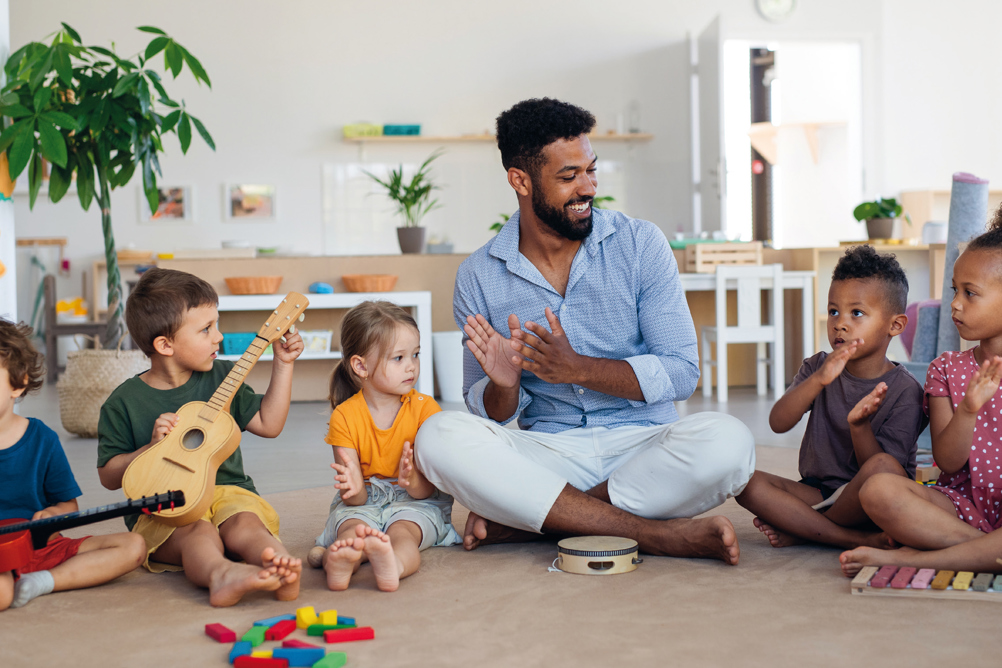
Music and early childhood are deeply intertwined. Research tells us that, even before birth, singing to babies in the womb can foster language acquisition and holistic development. As children grow, music continues to be an essential part of their learning journey, from songs and patterns to rhymes and rhythms, all of which help them develop a sense of self and connection with others. Music moves children in deeply embodied ways, helping them make sense of the world through rhythm and sound. In this article, I share a few reflections on musicality from my experience.
Custodians of a rich tradition
I have worked in and around early childhood for over a decade now, with musicality being a near-constant feature across all my work, directly and indirectly, with young children. At the outset, despite not considering myself ‘musical’ in a formal sense, I quickly amassed a repertoire of songs – many familiar to those in the early years sector. Most educators, I believe, have at least 10–15 ‘go-to’ songs for any occasion, from structured activities like circle time to ad hoc moments during free play. These songs become seasonal, cultural, and celebratory mainstays, whether for Christmas, Eid or other special occasions. Every time we sing, we breathe life into these musical stories, passing them along to new generations of children. In this sense, educators become custodians of a rich, ever-evolving tradition of musicality in early childhood, preserving and adapting it for the unique communities they serve.
What fascinates me is how songs and rhymes are interpreted differently across settings and cultural contexts. For example, I recently had the opportunity to visit a kindergarten in China. Clearly, music was as highly valued as in western early years settings. However, a key difference was the teacher's frequent use of a piano to accompany singing (which they call ‘piano pedagogy’), in contrast to the UK, where instruments tend to be less common in everyday practice. This highlights music's contextual and culturally embedded nature in early childhood settings.
Music's role in strengthening bonds
As I transitioned into a family support role, my connection to music expanded beyond children to include their families. I had the privilege of training in the Rockabye programme, which supports the parent-child connection through music and sensory play – particularly for those who experience difficulty bonding. This 12-week programme, run in children's centres across Bristol, welcomes parents and their babies to share their experiences of parenthood, engage in sensory activities, and connect through song and dance.
I found these sessions to be an eye-opening reminder of how music isn't only about child development – it's a crucial tool for family connection, grounding parents in shared experiences and memories with their babies. Singing became a bridge for parents to communicate with their infants, strengthening bonds through rhythm, melody and emotional resonance.
Space for inclusivity
In recent years, I've had the opportunity to work alongside inspiring music educators and organisations committed to supporting children's musicality while integrating social justice and anti-racist principles into their practice. Together, we've explored how music can serve as a space for inclusivity and equity, allowing children to explore their identities and cultural backgrounds through song.
Working with these organisations has reinforced my belief that music is a natural medium for social justice work. Children should hear songs that reflect a diversity of cultures and experiences that resonate with them personally and socially. This focus allows music to be a space where children see themselves and others, which is vital for fostering empathy, understanding and respect from a young age.
Music remains a powerful tool for early childhood educators. Whether you're a seasoned musician or someone who simply enjoys singing with young children, remember that musicality in early childhood isn't about technical skill. It's about creating moments of connection, joy and learning through the sounds and rhythms that resonate with children.
In conclusion, fostering musicality in early childhood offers unique opportunities for educators to connect with children on a personal level, support families, and work toward inclusive, socially just practices. When used thoughtfully, music is a universal language that helps children feel seen, heard and valued. In embracing it, educators can provide children with a lifelong appreciation for diversity, rhythm and self-expression – tools that will serve them far beyond their early years.




